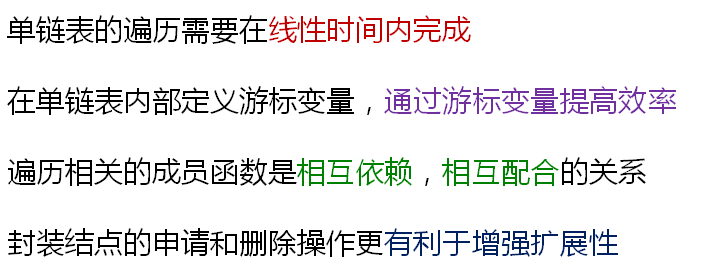原文:https://www.cnblogs.com/wanmeishenghuo/p/9650726.html 参考狄泰软件相关教程
问题:
如何遍历单链表中的每一个元素?
示例:
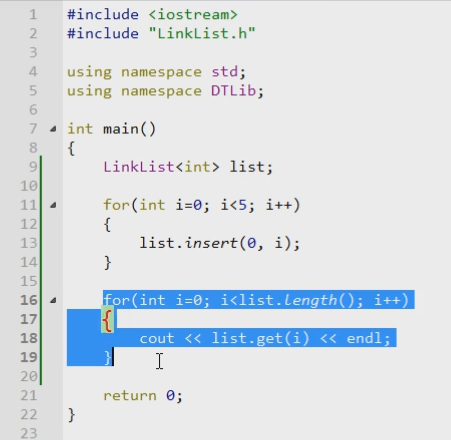

在头部插入元素时,时间复杂度是O(n)。 获取元素时,时间复杂度是O(n*n),因为内层定位位置时有一个O(n)复杂度。
从理论上来说遍历一个单链表,只需要线性的时间就够了。
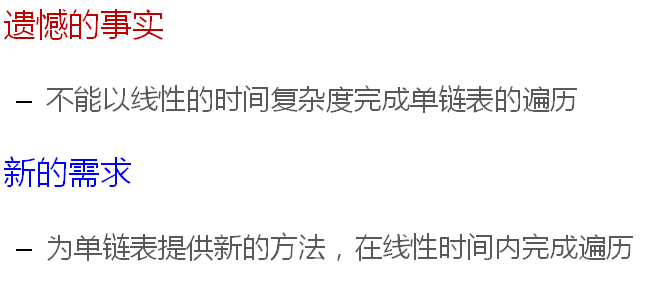
设计思路:
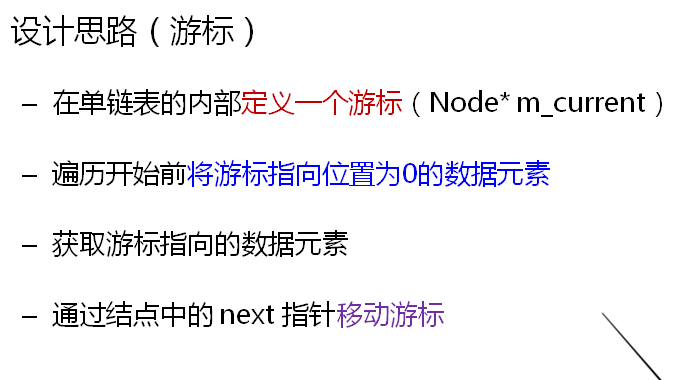
提供一组相关的遍历函数,遍历时使用这些函数来操作:

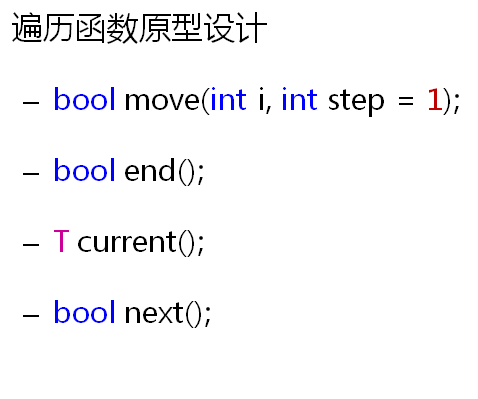
move函数的i参数为目标位置,step参数为每次移动的节点数。
end用来判断当前的游标是否到达了单链表的尾部。
current返回当前游标指向的数据元素。
next移动游标,移动的次数根据move中的step的值来决定。
遍历时,这四个函数必须配合使用才能得到最大效率。
改进LinkList.h文件中的函数:
#ifndef LINKLIST_H
#define LINKLIST_H
#include "List.h"
#include "Exception.h"
namespace DTLib
{
template < typename T >
class LinkList : public List<T>
{
protected:
struct Node : public Object
{
T value;
Node* next;
};
mutable struct : public Object
{
char reserved[sizeof(T)];
Node* next;
}m_header;
int m_length;
int m_step;
Node* m_current;
Node* position(int i) const // O(n)
{
Node* ret = reinterpret_cast<Node*>(&m_header);
for(int p = 0; p < i; p++)
{
ret = ret->next;
}
return ret;
}
public:
LinkList()
{
m_header.next = NULL;
m_length = 0;
m_step = 1;
m_current = NULL;
}
bool insert(const T& e)
{
return insert(m_length, e);
}
bool insert(int i, const T& e) // O(n)
{
bool ret = ((0 <= i) && (i <= m_length));
if( ret )
{
Node* node = new Node();
if( node != NULL )
{
Node* current = position(i);
node->value = e;
node->next = current->next;
current->next = node;
m_length++;
}
else
{
THROW_EXCEPTION(NoEnoughMemoryException, "No memery to insert new element...");
}
}
return ret;
}
bool remove(int i) // O(n)
{
bool ret = ((0 <= i) && (i < m_length));
if( ret )
{
Node* current = position(i);
Node* toDel = current->next;
current->next = toDel->next;
delete toDel;
m_length--;
}
return ret;
}
bool set(int i, const T& e) // O(n)
{
bool ret = ((0 <= i) && (i < m_length));
if( ret )
{
position(i)->next->value = e;
}
return ret;
}
T get(int i) const
{
T ret;
if( get(i, ret) )
{
return ret;
}
else
{
THROW_EXCEPTION(IndexOutOfBoundsException, "Invalid parameter i to get element ...");
}
return ret;
}
bool get(int i, T& e) const // O(n)
{
bool ret = ((0 <= i) && (i < m_length));
if( ret )
{
e = position(i)->next->value;
}
return ret;
}
int find(const T& e) const // O(n)
{
int ret = -1;
int i = 0;
Node* node = m_header.next;
while( node )
{
if( node->value == e )
{
ret = i;
break;
}
else
{
node = node->next;
i++;
}
}
return ret;
}
int length() const // O(1)
{
return m_length;
}
void clear() // O(n)
{
while( m_header.next )
{
Node* toDel = m_header.next;
m_header.next = toDel->next;
delete toDel;
}
m_length = 0;
}
bool move(int i, int step = 1)
{
bool ret = (0 <= i) && (i < m_length) && (step > 0);
if( ret )
{
m_current = position(i)->next;
m_step = step;
}
return ret;
}
bool end()
{
return (m_current == NULL);
}
T current()
{
if( !end() )
{
return m_current->value;
}
else
{
THROW_EXCEPTION(InvalidOperationException, "No value at current position ...");
}
}
bool next() //每次移动step步
{
int i = 0;
while((i < m_step) && !end())
{
m_current = m_current->next;
i++;
}
return (i == m_step);
}
~LinkList() // O(n)
{
clear();
}
};
}
#endif // LINKLIST_H
第27、28行我们添加了两个成员变量,第185-226行添加了遍历需要的函数。
测试程序如下:
#include <iostream>
#include "LinkList.h"
using namespace std;
using namespace DTLib;
int main()
{
LinkList<int> list;
for(int i = 0; i<5; i++)
{
list.insert(0,i);
}
//遍历时必须先调用move函数
for(list.move(0); !list.end(); list.next())
{
cout << list.current() << endl;
}
return 0;
}
遍历list时必须先调用move函数,指定位置和步进值step,step是给next函数用的,例如:step为5,则每次调用next函数就会向后移动5个元素。
结果如下:
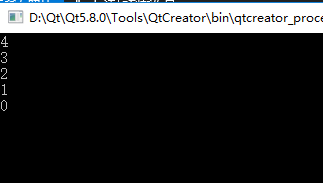
这时的遍历操作时间复杂度是O(n)。
步进值为2时,结果如下:
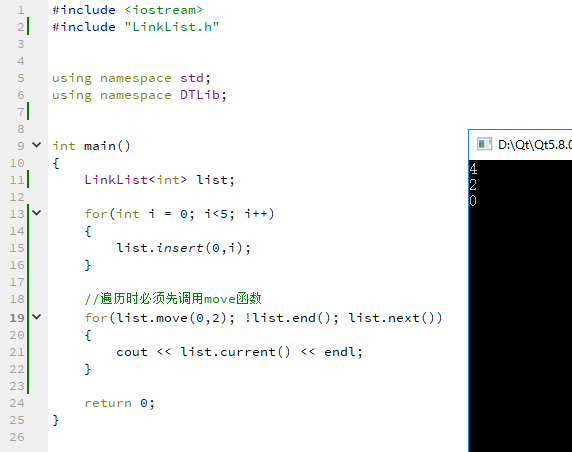
单链表内部封装:

程序改进:
#ifndef LINKLIST_H
#define LINKLIST_H
#include "List.h"
#include "Exception.h"
namespace DTLib
{
template < typename T >
class LinkList : public List<T>
{
protected:
struct Node : public Object
{
T value;
Node* next;
};
mutable struct : public Object
{
char reserved[sizeof(T)];
Node* next;
}m_header;
int m_length;
int m_step;
Node* m_current;
Node* position(int i) const // O(n)
{
Node* ret = reinterpret_cast<Node*>(&m_header);
for(int p = 0; p < i; p++)
{
ret = ret->next;
}
return ret;
}
virtual Node* create()
{
return new Node();
}
virtual void destroy(Node* pn)
{
delete pn;
}
public:
LinkList()
{
m_header.next = NULL;
m_length = 0;
m_step = 1;
m_current = NULL;
}
bool insert(const T& e)
{
return insert(m_length, e);
}
bool insert(int i, const T& e) // O(n)
{
bool ret = ((0 <= i) && (i <= m_length));
if( ret )
{
Node* node = create();
if( node != NULL )
{
Node* current = position(i);
node->value = e;
node->next = current->next;
current->next = node;
m_length++;
}
else
{
THROW_EXCEPTION(NoEnoughMemoryException, "No memery to insert new element...");
}
}
return ret;
}
bool remove(int i) // O(n)
{
bool ret = ((0 <= i) && (i < m_length));
if( ret )
{
Node* current = position(i);
Node* toDel = current->next;
current->next = toDel->next;
destroy(toDel);
m_length--;
}
return ret;
}
bool set(int i, const T& e) // O(n)
{
bool ret = ((0 <= i) && (i < m_length));
if( ret )
{
position(i)->next->value = e;
}
return ret;
}
T get(int i) const
{
T ret;
if( get(i, ret) )
{
return ret;
}
else
{
THROW_EXCEPTION(IndexOutOfBoundsException, "Invalid parameter i to get element ...");
}
return ret;
}
bool get(int i, T& e) const // O(n)
{
bool ret = ((0 <= i) && (i < m_length));
if( ret )
{
e = position(i)->next->value;
}
return ret;
}
int find(const T& e) const // O(n)
{
int ret = -1;
int i = 0;
Node* node = m_header.next;
while( node )
{
if( node->value == e )
{
ret = i;
break;
}
else
{
node = node->next;
i++;
}
}
return ret;
}
int length() const // O(1)
{
return m_length;
}
void clear() // O(n)
{
while( m_header.next )
{
Node* toDel = m_header.next;
m_header.next = toDel->next;
destroy(toDel);
}
m_length = 0;
}
bool move(int i, int step = 1)
{
bool ret = (0 <= i) && (i < m_length) && (step > 0);
if( ret )
{
m_current = position(i)->next;
m_step = step;
}
return ret;
}
bool end()
{
return (m_current == NULL);
}
T current()
{
if( !end() )
{
return m_current->value;
}
else
{
THROW_EXCEPTION(InvalidOperationException, "No value at current position ...");
}
}
bool next() //每次移动step步
{
int i = 0;
while((i < m_step) && !end())
{
m_current = m_current->next;
i++;
}
return (i == m_step);
}
~LinkList() // O(n)
{
clear();
}
};
}
#endif // LINKLIST_H
调用new生成Node的地方我们全换成了create函数,调用delete销毁Node的地方我们全换成了destroy函数。
问题:
封装这两个函数的意义是什么?
小结:
